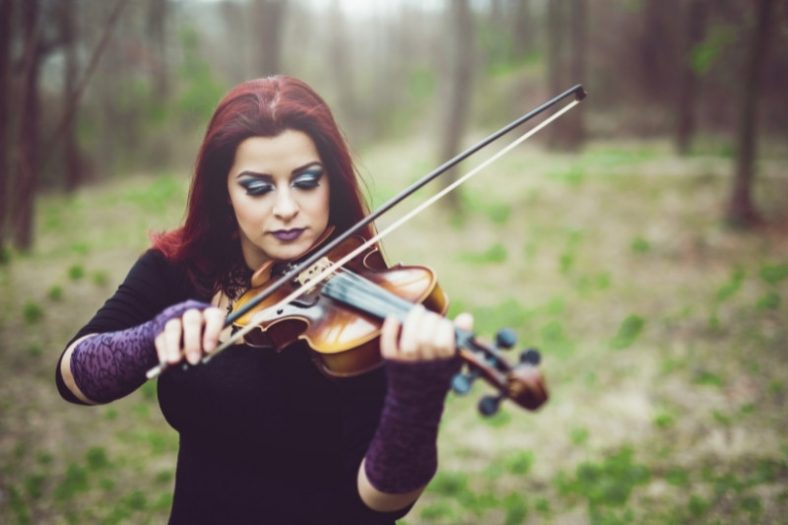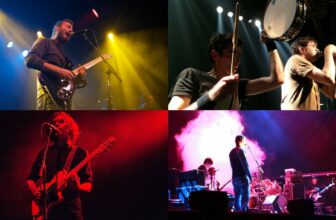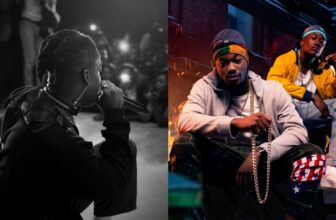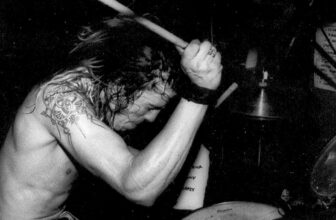10 Types Of Goth Music

Goth subculture is an often misjudged expressive and diverse subculture. Originating in the late-1970s, the Goth subculture is a sum of fashion styles, musical tastes, preferences, perspectives on life, and belief systems that find beauty in the dark, mysterious, and morbid.
Gothic subculture was born from the fans of bands like The Cure, Banshees, Joy Division, Siouxsie, and others. The music scene and the fashion styles of these bands’ fans inspired the Gothic perspective, eventually becoming a culture. Today, there are many goths in countries like Japan, Germany, and the United States.
The common ground in all Goths is appreciating dark and mysterious things. The creepy and dark aspects of life are the core individual traits and aspects of Goths. And the music, fashion, and perspective are all shaped by that dark and creepy love in the center of the culture.
As it is a diverse subculture that finds dark and creepy elements of life interesting and beautiful, it evolved into a subculture with many different styles, beliefs, and disciplines. Let’s explore the different types of Goth music to understand the world of the Goths better.
Contents
1. Dark Wave
Dark Wave was born from the new wave and post-punk movement in the late 70s. It is characterized by introspective lyrics, minor-key focus, dark, romantic, and feelings of sorrow. Many Trad Goths are considered to be part of the Dark Wave movement.
Trad or traditional Goths are seen as the pure and original form of Goth culture. As the birth of the culture is heavily associated with the punk and rock scene, traditional Goth music can also be described as Gothic or Goth Rock.
The music is similar to punk and rock songs but has a darker concept in its melodies and lyrics. Some famous artists are Cocteau Twins, Dead Can Dance, Bauhaus, The Cure, and In The Nursery.
The clothes and accessories of Trad Goths are almost always dark, including black leather apparel, fishnets, ripped shirts, and dark makeup. Another common ground is the gloomy and melancholy themes in the music and lives of Trad Goths.
2. Ethereal Wave
Ethereal Wave or Ethereal Goth is a major subgenre of Dark Wave Music. It is described as the traditional early 1980s post-punk and gothic rock signature with gothic, romantic, and otherworldly ambiance and lots of effects used in songs for ethereal tones.
The subgenre was born in the U.K. during the 80s. Bands such as This Mortal Coil, Cocteau Twins, and early Dead Can Dance are the biggest representatives of the genre.
The music and the lyrics share the same ground with Dark Wave and Trad Goth music, but the distinction is with the tone of Ethereal Wave. The ethereal wave songs have effects-laden guitar soundscapes that create a serious, dark, and wistful atmosphere. The sound commonly features high-pitched female vocals, restrained tempo, and post-punk-style basslines.
3. Cold Wave
Cold Wave is a musical genre associated with post-punk, dark wave, and goth movements. The genre has a loose frame without clear definitions. Still, it is characterized by its use of early electronic music during the late 70s, detached lyrical concepts and minimalist style, and general approach.
Cold Wave was born from punk-rock bands in the 70s in Europe. The first distinction of the genre was its heavy use of portable synthesizers, considered one of the earliest uses of electronic music instruments.
As the name suggests, the overall tone of Cold Wave music is quite cold. It is also referred to as punk with a depressive groove. Les Provisoires, Asylum Party, Siouxsie, and the Banshees are the most famous names of the cold wave scene.
4. Minimal Wave
Minimal Wave, as a type of Goth music, features minimal musical structures, unpolished production, and heavy use of analog synths and drum machines. Mechanical beats, short repetitive patterns, and thin melodies with heavy synths combined with avant-garde lyrics embody this type of Goth music.
The minimal wave was born in the late 70s and did not have a name until the 2000s. A record label called ‘Minimal Wave’ decided to put a name after they re-released many albums of the genre. The most popular bands of the genre are Lebanon Hanover, Martial Canterel, and Oppenheimer Analysis.
The genre was also named synthpop, new wave, and techno-pop and is closely related to cold wave and goth music. Depeche Mode, Orchestral Manoeuvres in the Dark, and John Foxx are seen as the influential origins of the genre.
5. Goth Pop (Dream Pop)
Goth Pop or Dream Pop is a subgenre of neo-psychedelia and alternative rock music. It was born in the 80s and put ambient sounds and sonic texture along with catchy pop melodies as its core characteristics. Goth pop resembles shoegaze or ethereal wave music with its tonal qualities.
Dream pop often features breathy vocals, heavy effects on guitars such as reverb, tremolo, chorus, and flangers, distorted guitars, heavy synths, catchy melodies, and choruses, along with introspective and existential lyrics.
The sonic texture is as important as the melody itself, and tonal qualities play a big role in goth-pop music. The most famous names of the genre are A.R. Kane, Cocteau Twins, and My Bloody Valentine.
6. Death Rock
With its gothic and horror elements, Death Rock is another style of Goth music that emerged from punk rock during the 80s. The music is rhythmically repetitive, and the guitars are highly effect-loaded. The lyrics are surreal, dark, and introspective, talking about death, life, gloom, and isolation.
Death Rock music is quite similar to punk rock, but the style can vary a lot from upbeat and melodic to harsh and dark. The song’s themes are the clearest distinction as the lyrics and the melodies tell stories of horror and sci-fi movies. Some artists even shift to rockabilly depending on the theme of the song.
Some famous Death Rock artists are Kommunity FK, Zombina, the Skeletones, and Christian Death.
7. Southern Gothic
Southern Gothic or Dark Country is a subgenre of American acoustic-based alternative rock and country music. It blends the dark and mysterious lyrical content of Goth culture with American country, folk, and gospel music. The songs discuss religious and esoteric imagery, crime, poverty, and life.
Southern American culture, combined with the Goth culture, offers a large literature called Southern Gothic or Gothic Americana. The culture is large and based on this literature, including music.
The music takes the themes from the literature, which talks about criminal behavior, poverty, and religious and esoteric topics, especially hoodoo, death, family, love, life, alcohol, the devil, and betrayal. The topics are often dark, mysterious, and gloomy, which is the Gothic part of the culture.
The most famous names in the Southern Gothic scene are Connor Christian & Southern Gothic and 16 Horse Power.
8. Goth Folk
Goth Folk is a style of Goth music and Neofolk. It is an experimental music genre that combines the elements of industrial and folk music with punk rock. The songs use archaic, cultural, and literary references, while the music is often created with a blend of acoustic folk instruments.
Goth Folk songs typically feature lyrics about local traditions, indigenous beliefs, esoteric metaphors, historical topics, and existential feelings.
Some famous names of the genre are Bat for Lashes, Patrick Wolf, Fever Ray, Mazzy Star, and Bjork.
9. Goth Neo-Classical
The combination of Goth culture, ethereal atmosphere, otherworldly vocals, and classical music creates the Goth Neo-Classical subgenre. The music features melancholy and nostalgia themes with extensive orchestral elements. The genre uses medieval European sound combined with Goth lyrics.
Goth Neo-Classical or Neo-Classical Dark Wave was born during the 80s in Europe. The music had classic orchestral elements as well as modern sounds of synths or electric guitars. The main tonal quality could be anywhere between a symphonic and post-industrial sound.
Some popular examples of the genre are the ‘Spleen and Ideal’ album of Dead Can Dance and the ‘Stormhorse’ album of In The Nursery.
10. Goth Industrial
The robotic perspective of industrial music combined with Goth culture gives birth to Goth Industrial, mechanized music with lyrics on evil in the world. The gritty futuristic and post-apocalyptic themes are always present in the genre, and the music is often combined with performance art.
Goth Industrial music uses lots of synths, effects, drum machines, tape loops as well as classic instruments to create the mechanized music of the post-apocalyptic industrial world. The lyrics also go with the same theme talking about animal cruelty, robotized humans, corrupted system, surrealism, and literature.
The music is heavily in contact with literature, and other arts as performance arts often accompany the music. The lyrical content feeds upon the likes of Friedrich Nietzsche, Marquis de Sade, futurism, surrealism, and dystopian worlds.
The famous representatives of the subgenre are Skinny Puppy, Leæther Strip, Front 242, and Frontline Assembly.
What are the characteristics of Goth music?
The main characteristic of Goth music is the dark and mysterious feeling felt in the music and lyrics. The music is fed upon the Goth culture, including the dark leather clothing, the distinct perspective on life, and the focus on dark, gritty aspects of life.
There are many subgenres and different subculture branches in Goth music and culture. You can find acoustic folk Goth music as well as mechanized robotic music as in Goth Industrial. The common ground is not a frame of musical style but a culture and a feeling.
What represents Gothic Fashion?
Gothic fashion is a whole world in and of itself. With many styles like Bubble Goth, Romantic Goth, and Victorian Goth, the fashion, depending on the specific style, mostly consists of wearing dark clothes, bracelets, jewelry, belts, chains, and corsets.
Who are the most famous Goth musicians/bands?
Some famous Goth musicians and bands are The Cure, Bauhaus, The Sisters of Mercy, Dead Can Dance, Siouxsie, and the Banshees, Joy Division, Cocteau Twins, and Type O Negative.
Conclusion
Goth music is a diverse and expressive genre and culture that is commonly mistaken because of the lazy stereotypes and prejudices of some people. They are commonly thought of as dark, gloomy, isolated Satanists who are always depressed and obsessed with death.
This is a big misconception as Goth music has a lot to offer, and Goth culture is much more diverse than it is thought to be. Goth music is full of mysticism, passion, beauty, and majesty, along with mystery, terror, violence, pain, and love.
Goth culture and music create a balance between dark and light, accepting the dark life that many people run away from. By listening to the different subgenres of Goth music, you can explore and understand the Goth world and perspective much better to break the illusion of stereotypes.





